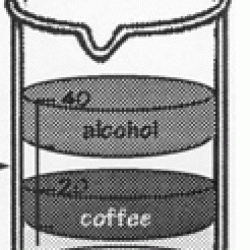Source Institutions
Source Institutions
Add to list Go to activity
Activity link broken? See if it's at the internet archive

Learners pour equal amounts of coffee, mineral oil, corn syrup, and alcohol into a beaker. The liquids resolve into stacked layers, and learners can infer which liquids are the most and least dense. Learners then place small objects into the beaker and predict where the objects will float. Learners discover that different liquids have different densities, the ability of an object to float depends on the density of the object and the density of the liquid, and that not all liquids will mix. Even though this activity is no longer in active use in OMSI's Chemistry Lab, it remains an interesting and inspiring activity for groups of learners.
- 10 to 30 minutes
- 10 to 30 minutes
- $1 - $5 per group of students
- Ages 11 - 18
- Activity, Experiment/Lab Activity
- English
Quick Guide
Materials List (per group of students)
- One 50-ml glass beaker
- One 500-ml plastic beaker (for waste )
- One 3-in.-diameter strainer to fit in the waste beaker
- One 600-ml beaker
- One petri dish lid (or other small plastic container)
- Ice
- About one dozen assorted small objects made variously of wood, glass, plastic, and metal (plastic game pieces, etc.)
- (avoid using sharp objects or very small parts)
- Corn syrup (1 gal)
- Cold coffee (1 L per day)
- Mineral oil (1 gal)
- C2H5OH (ethyl alcohol or ethanol) (1 gal)
- Green food coloring
- Two 125-ml plastic squeeze bottles
- One 125-ml dropper bottle
- One 125-ml plastic bottle
- Two 1000-ml plastic bottles
Subjects
-
Physical Sciences
-
States of Matter
- Liquids
-
Structure and Properties of Matter
- Volume and Density
-
States of Matter
Audience
To use this activity, learners need to:
- see
- see color
- read
- touch
Learning styles supported:
- Involves hands-on or lab activities
Other
This resource is part of:
Access Rights:
- Free access
By:
Rights:
- All rights reserved, Oregon Museum of Science and Industry, 1997
Funding Source:
- National Science Foundation
